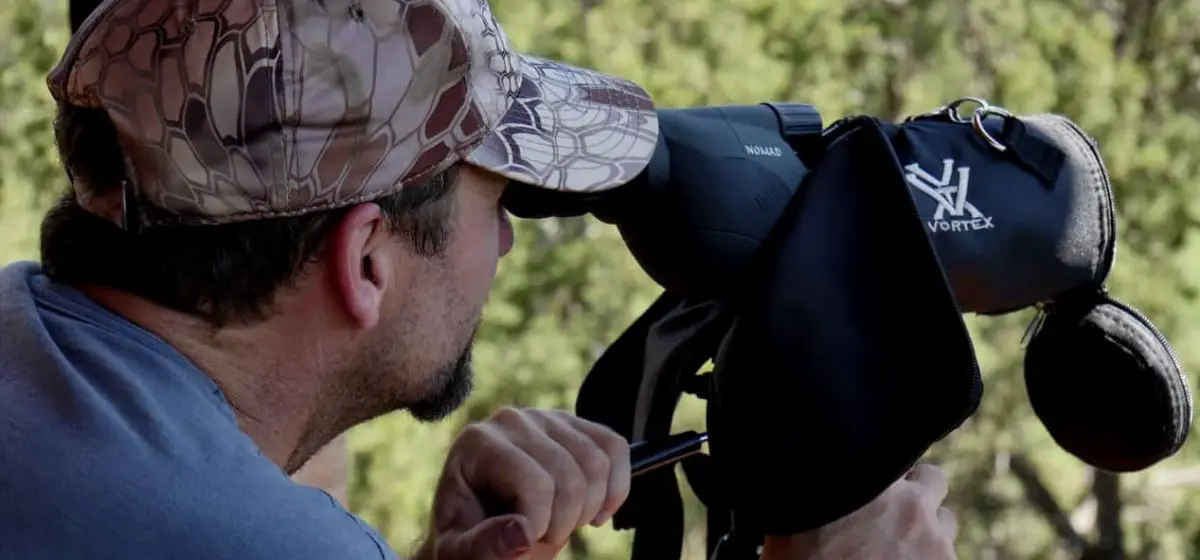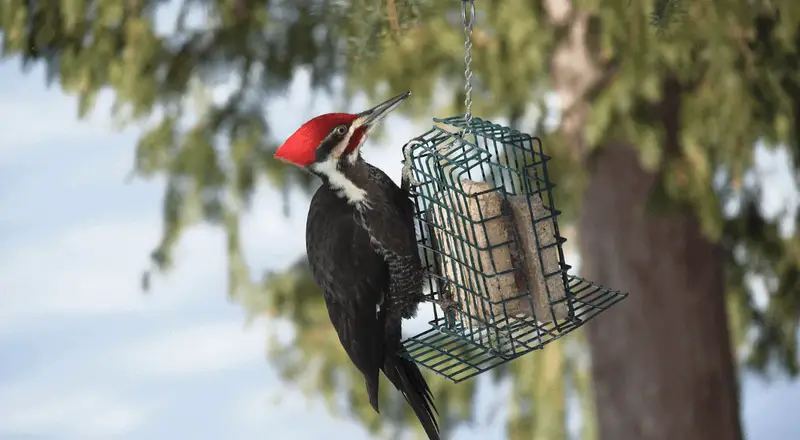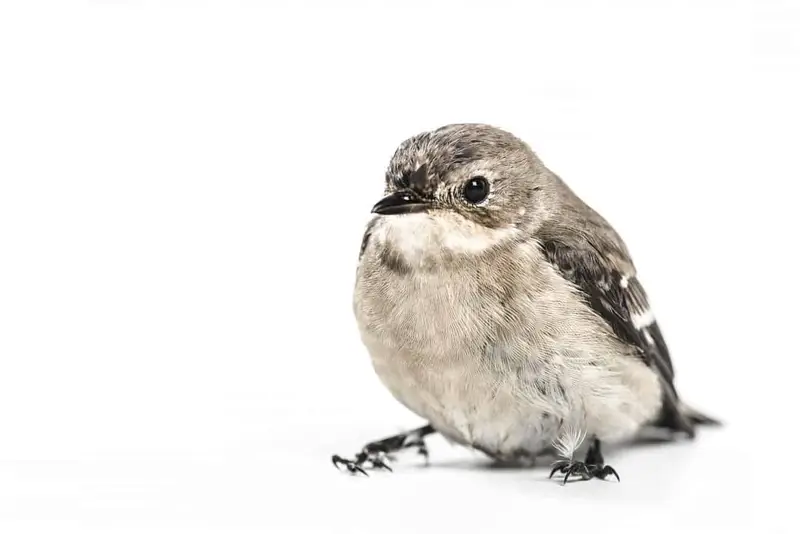
When it comes to birdwatching, you want to make sure that you have the right type of gear. Well, it’s actually easier than you might think. You don’t have to spend a fortune in order to do it either. Rather, you want to get a spotting scope to help you see what’s really going on out there, no matter what type of birds you want to watch (or where).
Table of Contents
Toggle
The great thing about spotting scopes is that you can get excellent focus and clarity. You’ll be able to find a scope that lets you get a lot better zoom and image than you can possibly find with binoculars, and that gives you the ability to really take your birdwatching to the next level. If you’re interested in being able to see what’s going on at the top of a nest or high up in the sky, you’ll need a scope to be able to do it.
Getting a scope means that you can see all of the details that you’ve been missing out on by using binoculars, and you can do it without spooking the birds as well. How many times have you tried to get a really good look at a bird only to move too close and scare it off? That won’t happen with a spotting scope because you can get the perfect image from much further back. All you have to do is adjust the zoom, and you’re going to have the image that you want. And the bird is going to be able to continue doing what it’s doing. That means you get to do what you really want – watch them in their natural habitat.
Table of Contents
What is the best spotting scope for birding?
The Gosky spotting scope comes with a tripod that makes it easier to get a steady shot or to observe the birds for an extended period of time. It also has a carry bag included and a smartphone adapter so you can record everything that you see through the scope for sharing later on.
You’ll get an angled scope, which makes it easy to look down into, and which also gives you more range of motion on the image. On top of that, you’re going to have a waterproof and fogproof design, which protects your telescope no matter what’s going on outside. This also allows you to spend more time bird watching than cleaning your lenses.
The variable 20x to 60x magnification means that there’s very little you’re not going to be able to see while you’re birdwatching or while you’re doing any other activities. This scope is actually great for shooting, hunting, camping, astronomical observation, and a whole lot more. All you need to do is find something you want to look at.
What we like
- Water and fog-proof
- Smartphone adapter included
Drawbacks
- The tripod that's included could be of better quality
The LandLove Spotting Scope comes with a dynamic lens focusing system that will make sure you get the clearest possible image at any distance. It features 20 – 60x magnification which gives great versatility and also has a multi-coated 80mm green film lens.
You can use this lens for any purposes, from hunting and marine observation to birdwatching and astronomy. What’s even more important is that it’s fully fogproof, waterproof and shockproof. That makes it a great investment for anyone who wants to get out into the wilderness. You can still enjoy the wildlife without having to worry about your lens in less than ideal weather.
The digiscoping cell phone adapter means that you can easily take photographs of whatever you’re seeing through the lens. You’ll also have a tripod that you can set up on to get a steady image and a carrying case to keep everything protected until you get to your location. There’s even lens, and eyepiece covers included to protect the glass.
What we like
- Dynamic lens focusing
- Smart phone adapter included
- Water, shock and fog proof
Drawbacks
- Phone adapter can be a bit temperamental
For those who want something compact but high quality, this is definitely the way to go. The Roxant scope is completely weatherproof, with a rubber exterior that’s designed to be easier to hold onto, even when it gets a little wet out there. It has a textured focused ring directly on the barrel as well, which serves a dual purpose. First, it’s easier to find and use when you’re looking through the scope. And second, your hand isn’t going to slip on the knob.
You’ll get an adjustable eyepiece that is designed to work for those who have glasses and those who don’t, plus an extendable sunshade. That means you’re going to have less glare affecting the image you want to see. You’ll also have a larger objective lens and a 45-degree angle on the eyepiece to really get a good look at everything.
This scope has zoom of 12 – 36x and a 50mm objective lens to go along with it. On top of that, you’re going to get a tripod, a carrying case, and all of the caps you need to protect your glass.
What we like
- Adjustable eyepiece for glasses wearers
- Lifetime guarantee
- Military grade optics
Drawbacks
- Tripod included is not the best
With this Gosky spotting scope, you’re going to have all of the extras that you need to head out into the wilderness. You’ll get the scope itself as well as a carry bag to hold it, a tripod to set it up on, and even a phone adaptor so you can take pictures of the beautiful things that you’re seeing through your scope.
The eyepiece is angled at 45 degrees, making it easier for you to look into it with just the right amount of light. Inexpensive but still powerful, this unit gives you 20 – 60x zoom, so you can get a really good look at just about anything and everything that’s out there, whether it’s birds or other wildlife.
The lens is a multi-coated 60mm green film that provides you up to 110ft/1000 yards of view. You’ll also get a high-quality rubber exterior that protects this unit from drops and makes it easier for you to hold onto. Add in the shockproof and waterproof design, and you’ll have a scope that you can take with you just about anywhere and use any time that you want to.
What we like
- Retractable Shade
- 60mm green film, multi-coated lens
Drawbacks
- Image quality at high zoom isn't the best on the market
This inexpensive scope still provides you with some excellent features, even at a value price. It’s completely fogproof and waterproof, which means you don’t need to worry about the weather when you want to head out and take a look at the wildlife. You’ll be able to keep the lenses clear and comfortable, even with rain.
You get a phone mount as well as a tripod included so you can get your whole setup ready in no time. Plus, you’re going to have 20 – 60x zoom, which gets you in close to anything that’s out there. The field of view gives you up to 131 ft/1000 yards, which means you can still see plenty of what’s going on around the area and around your bird of choice.
The exterior is made with rubber to create a non-slip surface that you can hold onto more easily. Not only that, but it makes the whole thing more shockproof in case of drops. You’ll also have a focus ring right on the barrel and retractable eyepieces that can be used for those who wear glasses. You’ll also get excellent customer service that stands behind their products.
What we like
- Retractable eyepieces for glasses wearers
- Carry case included
Drawbacks
- The carry case can't hold accessories
With this scope, you’re getting something that’s small but still capable of a great deal of power. In fact, this scope has a zoom of 25 to 75x. On top of that, you’re going to have a case to carry it in and a tripod that you can take with you wherever you go. That way, you’re going to have a more stable surface to watch through.
This compact scope is great for use on land or in the air, including watching birds or watching astronomical events. You’ll get a great deal of versatility with the Maksutov-Cassegrain optical, and the 1.25” eyepiece is large enough for you to see everything with the right amount of light.
You’ll get a field of view up to 68ft/1000 yards, so you’re able to see everything that’s happening, no matter what you’re looking at. You’re also going to have slow-motion controls for the tripod, and you can swap out the eyepiece for another one if you have something else you prefer.
What we like
- Extremely sensitive focus adjustment
- Small, compact and lightweight
- Compression molded design mimics concrete basin
Drawbacks
- Eye-piece could be improved
Here you’re getting a scope that gives you plenty of features and capability for the price. You’ll have up to 60x zoom, which lets you get as close as possible to whatever it is that you want to watch. You’re also going to have a field of view that’s large enough to let you see more than just the bird you’re watching, but what’s around it as well.
You’re going to have a fully multi-coated lens that actually uses BAK4 roof prisms to make sure you get the absolute best lighting possible. Even when the conditions are dim, you’re still going to have the high-contrast that you’re looking for. Add in the dual focus wheel system, and you’re definitely going to have the image you want.
This unit is waterproof and fogproof to make sure you can use it whenever and wherever you want. On top of that, it’s made with a rubber exterior that makes it easier to hold onto and shockproof. That way, even if it gets dropped, you can still count on it to keep working.
What we like
- BAK4 roof prism
- Lightweight & compact
Drawbacks
- Image quality is reduced at higher zoom. Expected at this price.
You don’t have to actually be hunting to use this scope because it’s great for birdwatching as well. It has a multi-coated optical lens and gives you up to 60x zoom. That means you’re going to get up close and personal with any of the birds that you want to watch or anything else you want to keep an eye on.
This waterproof scope comes with a tripod and a smartphone adaptor, so you can easily take pictures of anything that you’re looking at for sharing later on. You’ll also get a high refractive index rate, which means you’re getting brighter images, even at the edges of the field of view.
On top of all of that, you’ll get a carry case that lets you take this scope with you wherever you want to go. The retractable sunshade means you won’t have to worry about glare while you’re checking out the scenery, and you will really like the field of view of up to 36m/1000m.
What we like
- Weather proof
- Durable material
Drawbacks
- Tripod included could be improved
If you’re looking for a lot of power, you’re going to like this spotting scope that comes with up to 60x. With that kind of zoom and an 80mm optical lens, you’re going to have no problem seeing anything and everything out there in the wilderness. What’s going to be even better is the quality of the scope itself.
This scope is waterproof and fogproof, which means you can use it even when the weather isn’t quite ideal. Plus, you’re not going to have to spend all of your time trying to clean the lenses or keep the scope protected. You can just enjoy the wildlife.
You can choose between several different styles and settings for this scope, but you’re going to get sharp zoom and an excellent two-year warranty no matter what. You’ll have no problem with lighting, even if the light around the scope is lower than what you would like. Plus, the brand is based in California and hires tech support from the US.
What we like
- Attachment for DSLR
- Made in USA
- Metal Alloy body
Drawbacks
- Carry case is not padded
You’re going to get a high magnification scope that gets up to 60x so you can get in as close as you want. You’ll get a prism that’s BK-7 and has fully-coated optics. It’s also a shockproof, waterproof, and fogproof system that lets you go birdwatching whenever and wherever you might want to go. Even when the weather isn’t good, you’ll be able to see clearly.
The compact size of this unit will make it easier to carry along. It even comes with a carry case that you can transport and store it in. When you’re ready to use it, you’ll have a tripod that makes it simple to steady and see whatever you want without the shaking.
The 60mm objective lens is large enough for you to get plenty of light, and you’re going to have a Porro prism to get you even more light. The great price point for this unit makes it good for even beginning birdwatchers. Not to mention you’ll have an easy time using it for seeing other wildlife and for target practice.
What we like
- Great value for money
- Compact size
Drawbacks
- Eye-piece doesn't adjust
With this spotting scope, you’re going to have a 60mm optical lens as well as up to a 60x zoom. That’s going to give you plenty of light as well as plenty of power to see things that are very far away. The XR multi-coated lens makes the image even brighter and even clearer for anything that you want to see.
With this lens, you’ll also have a twist-and-lock collar that lets you choose the glassing position that you want. On top of that, you can adjust the eyecup to get the most comfortable fit. It’s all about what fits your eyes and your face the best. All of this makes it easier for you to continue adjusting to whatever you like.
You’ll get a waterproof and fogproof unit that you can use without having to worry about the weather. You’ll also get focus at approximately 22 feet, and the rubber exterior is designed to make it easier to hold onto. Not only that, but it helps protect it from shock. That way, you don’t have to be as concerned if you happen to drop it.
What we like
- Twist-and-lock glassing position collar
- Water and fogproof
Drawbacks
- Sight relief a little on the small side
Available in multiple sizes, this scope is designed for hunting, but it’s going to give you all the power you need for birdwatching too. In fact, it’s 100% waterproof, which makes it great for use even in less-than-ideal weather. Add in the fact that the exterior is rubber to make it easier to hold onto, and you’ve definitely got something you can count on.
This unit is compact and comes with a modest tripod as well, so you won’t have any problem setting it up in smaller spaces. On top of that, you’re going to have no problem getting a clear picture of anything you want, from a further distance because this scope gets up to 48x magnification.
The multi-coated optics make for a clear picture with plenty of light, even in difficult lighting. You’ll also get a portable system that comes with a hard-sided case for even better protection. Add in the soft-sided secondary case, and you’re definitely going to have something you can count on.
What we like
- Included 2 cases
- Waterproof
Drawbacks
- Not entirely shockproof
FAQ's
Table of Contents
What are the different types of spotting scopes that are available?
There are two basic types of birdwatching scopes that you can use. The first is the refractor, which utilizes optical glass lenses. These lenses will bend the light and make it easier to see whatever it is you’re looking at. These are the more common style of scope, and they’re what those who are just getting into birdwatching would use. In fact, many birdwatchers will never choose to use anything other than a refracting scope because they’re simple to use, inexpensive to buy, and they work reasonably well for anything that you might need. These are the standard scopes that you might expect when it comes to searching the skies (or the trees) for anything.
The second option is the catadioptric, which uses mirrors in order to reflect light. These scopes are unique in style because they are shorter and fatter than standard scopes. They usually feature unique angles for the eyepieces and are extremely apparent to anyone who has seen one. The unique look is something that definitely calls out a more professional birdwatcher, though these are quite expensive and much more delicate. That means you’ll have a whole lot more variance every time you adjust something on a catadioptric scope. These are not for the casual birdwatcher, but for someone who is willing to put effort into what they are doing.
Both types of scopes will give you excellent results. Both are going to let you see the birds more clearly than with a standard pair of binoculars and will give you more control over the image. The difference is going to be in just how high quality you want it to be and how much you’re willing to pay for it. If you want the absolute best and money is no object, then the catadioptric is a great way to go. If you want to get started and not spend as much, you can absolutely start (and end) your birdwatching career with a refractor.
What are the different types of spotting scopes that are available?
1. Field of View (FoV)
Field of view is the widest area that you can see with your scope. In order to compare these settings in a fair manner, they are usually referred to as X linear feet at 1000 yards. This might be 60 linear feet at 1000 yards or 100 linear feet at 1000 yards. Each scope will have a different field of view though the larger the number, the more you’ll be able to see. With a spotting scope, you will generally get between 52.5 and 157 feet at 1000 yards.
2. Aperture
The aperture is the overall diameter of the objective lens. It will usually be measured in millimeters, such as 55mm or 32mm. The size for a spotting scope will generally be around 50mm to 90mm, giving you a good amount of light to create a clearer and sharper image. Keep in mind that the larger the aperture, the larger the scope is going to be, and that means it’s also going to be heavier. If you’re carrying it a long distance, you may want to sacrifice some clarity for weight.
3. Focus
You can get one of three different types of focus for your scope, and each one has different applications. Helical focus means that you can quickly change the focus, which is great for those who are watching birds in flight. You’ll be able to follow along and get quick adjustments for clarity. Rack and pinion focus is designed for those who want quick but smooth focus. They’re not commonly used for birdwatching but rather for astronomical reasons. Finally, knob focus is slow, but it gives you more precise images.
4. Focal Length
The focal length is actually two different lengths, with the first being the amount of space between the main lens and where the light of the image comes into your view. The second is the eyepiece focal length. The two together give you magnification, though the equation for this process can be a little complicated. In general, you take the focal length of your objective and divide it by the focal length of your eyepiece. This will give you the magnification. You’ll generally see this expressed as a ratio.
5. Eyepiece
There are a number of different styles of eyepieces, including some that are fixed or variable. You’ll also be able to choose between straight-through or angled pieces and a variety of different diameters. For most, a straight-through eyepiece is the way to go, though angled eyepieces are found more commonly with catadioptric scopes. Angled eyepieces can also be good in some instances for birdwatching because they let you get just the right amount of light into the lens and the scope itself. The diameter of the eyepiece will generally be between 0.96” and 1.25” if you’re looking for something convenient and easy to use.
What are the benefits for the bird of a spotting scope?
One of the biggest benefits for the bird with a spotting scope is that you can get a clearer and sharper image without actually getting closer. That means you’re going to be leaving the bird to its own devices. You’ll be able to get a good image and still make sure that you let the bird care for its nest and eggs. Because you don’t have to worry about moving in closer, you also don’t have to worry about missing the image that you’re looking for. You’ll be able to see the bird and what it’s doing without worrying about scaring it off in the process, so you get a better shot.
How heavy are spotting scopes?
The weight of your spotting scope will vary based on the quality and type of scope you choose to get. In general, the lower the magnification of your spotting scope, the lower the weight, and vice versa. If you’re looking for a scope that will really get you up close and personal without needing to move, you’re going to sacrifice in the way of weight. Scopes that are higher magnification could weigh upwards of 70 ounces. While that may not sound like much on its own, it absolutely is when you’re talking about carrying it a long-distance or holding it for an extended period of time.
Conclusion
Any of these spotting scopes will help you to see anything and everything you want to see. Whether you’re only using your scope for birdwatching, or you’re planning for it to double as something else entirely, you’re going to have a range of great options with our top twelve. Just take a look and see which one will get you the features you need.

More Articles.

How to attract Woodpeckers to your yard?
Woodpeckers are often elusive to the sight but distinct to the ears. Their famous pecking

How to attract Chickadees to your yard?
Chickadees, despite their strange name, are a staple of the countryside across all of North

How to Attract Bees to Your Yard?
Bees play a vital role in the environment, helping to spread the pollen of flowers

About Us
We are avid bird-watchers who recently retired, allowing us more time to travel the world. Fortunately, we have managed to visit numerous countries around Europe, Asia, and America. Watching and photographing birds has been a passion for many years and we are making the most of the extra time on our hands!













